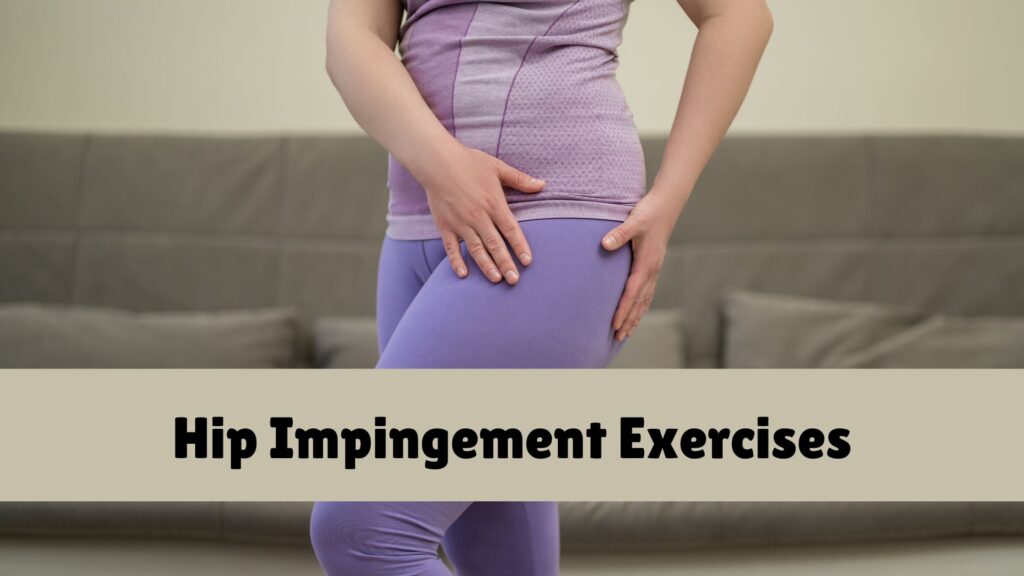If you are someone who struggles with hip impingement, you know how frustrating it can be to deal with the pain and limited mobility that comes with it. However, there is hope. By incorporating hip impingement exercises into your routine, you can improve your hip flexibility, mobility, balance, and strength. In this blog post, we will explore the importance of hip impingement exercises and how they can help you improve your hip flexor stretch.
Understanding Hip Impingement and Its Impact on Mobility
Hip impingement, medically referred to as femoroacetabular impingement (FAI), arises from an abnormal interaction between the hip joint’s ball and socket. This irregular contact can lead to discomfort, a diminished range of motion, and a significant reduction in mobility. The roots of FAI often trace back to congenital structural anomalies or can be the result of repetitive strain and overuse of the hip joint. These factors can cause the hip bones to not fit together perfectly, leading to friction and joint damage over time. Individuals with FAI may experience a variety of symptoms including stiffness, sharp pain, or a deep ache in the groin area during or after movement. Activities that involve bending or turning can exacerbate these symptoms, making everyday motions challenging and painful. The impact of hip impingement on mobility is profound, as it can hinder one’s ability to perform basic functions and movements, such as walking, sitting for prolonged periods, or engaging in physical activities. Understanding the dynamics of FAI is crucial for managing its symptoms and working towards improving joint mobility and overall hip health.
The Importance of Hip Flexibility and Mobility
Maintaining optimal hip flexibility and mobility stands as a cornerstone for not just athletes but for anyone aiming to lead a healthy, active lifestyle. This pivotal aspect of physical health serves as a protective mechanism against a spectrum of injuries by ensuring that the hip joint functions within its full range of motion smoothly and without undue stress. For those grappling with hip impingement, prioritizing hip flexibility and mobility transcends basic health maintenance—it becomes a critical intervention strategy. Enhanced flexibility in the hip area aids in alleviating the compression and irritation characteristic of femoroacetabular impingement, thereby reducing the risk of aggravating the condition. Furthermore, proficient hip mobility facilitates the correction of movement patterns that may contribute to or exacerbate impingement symptoms. It enables the hip joint to move freely and efficiently during both everyday and specialized movements, thereby minimizing the likelihood of compensatory strategies that could lead to further discomfort or injury. Engaging in targeted exercises aimed at expanding the range of motion and enhancing the suppleness of the hip joint empowers individuals to navigate their daily activities with greater ease and less pain. This emphasis on nurturing hip flexibility and mobility is not only crucial for mitigating immediate symptoms but also for fostering long-term hip health and functionality.
Starting with the Basics: Warm-Up Exercises
Embarking on a regimen of hip impingement exercises should always commence with foundational warm-up activities. These preliminary steps are instrumental in acclimating the body to subsequent, more strenuous exercises, ensuring a smooth transition into a workout that focuses on alleviating hip impingement. Engaging in light, dynamic stretches is an effective way to initiate muscle warmth, particularly targeting the hip region to enhance flexibility right from the outset. Utilizing a foam roller can also play a pivotal role during this phase, as it assists in loosening tight muscles and improving blood circulation to the areas that will be heavily involved in the upcoming exercises. Incorporating movements such as leg swings and hip circles not only elevates the heart rate but also lubricates the hip joints, preparing them for the range of motions they will soon undergo. This approach to warming up is not just about physical readiness; it also sets a mental groundwork, allowing for a focused and mindful exercise session. It’s a crucial step that shouldnizes the body and mind, paving the way for a productive session that targets hip impingement with precision and care.
Hip Flexor Stretch: The Key Exercise for Hip Impingement
The hip flexor stretch stands out as a pivotal maneuver for individuals battling hip impingement. By focusing on the iliopsoas group—comprising the psoas major and iliacus muscles—this stretch directly addresses one of the primary contributors to the discomfort and restricted motion associated with this condition. Tightness in these muscles often exacerbates the impingement by increasing pressure on the hip joint, thereby limiting its range of motion and contributing to the pain cycle.
Executing the hip flexor stretch involves a deliberate, controlled approach to gently elongate these muscles. This can be achieved through a variety of techniques, such as the kneeling hip flexor stretch, where one foot is placed forward, and the opposite knee is positioned on the ground, creating a significant stretch through the front of the hip on the kneeling side. Advanced variations can incorporate tools like resistance bands or incorporate dynamic movements to deepen the stretch further.
Consistent practice of this stretch not only aids in loosening the hip flexors but also contributes to a reduction in the overall tightness felt throughout the hip area. It’s a critical step in a comprehensive regimen aimed at mitigating the symptoms of hip impingement. Integrating this exercise into a daily routine can markedly improve one’s range of motion, thus playing a crucial role in the journey toward achieving better hip health and enhanced mobility.
Enhancing Hip Mobility: Complementary Exercises
To complement the hip flexor stretch and further bolster hip mobility, incorporating a diversified array of exercises into your regimen is crucial. Focusing on movements that target the surrounding musculature can offer significant relief from hip impingement symptoms while promoting greater functional movement. Key exercises include:
- **Hip Abductor Strengthening**: Exercises such as side-lying leg lifts work the muscles on the outer thigh and hip, crucial for lateral movement stability. Engaging these muscles helps in distributing load more evenly across the hip joint, reducing the risk of exacerbating impingement.
- **External Rotator Exercises**: Movements targeting the external rotators of the hip, like seated or lying external rotations, can improve the rotational mobility of the hip, allowing for a smoother movement pattern that avoids the pinching sensation often associated with hip impingement.
- **Glute Strengthening**: Strong glutes are fundamental for hip support and stability. Incorporating exercises such as hip thrusts and glute bridges into your routine not only aids in mitigating load on the hip joint but also enhances overall lower body strength, crucial for reducing compensatory movements that can lead to further discomfort.
- **Stretching the Hip Adductors and Hamstrings**: Given that tightness in these areas can contribute to restricted hip mobility, implementing stretches targeting the inner thighs and the back of the thighs can further aid in alleviating the pressures on the hip joint, promoting a more extensive range of motion.
Integrating these exercises offers a holistic approach to improving hip mobility, each playing a role in addressing the different facets of hip impingement and contributing to a more balanced and functional hip joint.
Must Read: Cervical Radiculopathy: Managing Stenosis with Neck Tilts
Building Strength and Balance for Long-Term Improvement
Achieving enduring benefits from hip impingement exercises demands a focus on strengthening and balancing the muscles that support the hip joint. Key activities such as hip bridges, clamshells, and single-leg squats are instrumental in this aspect. These exercises target the core and lower body, reinforcing the musculature that encapsulates the hip, thereby elevating stability and enhancing functionality. Hip bridges activate the glutes and hamstrings, foundational for hip support. Clamshells focus on the outer hip muscles, crucial for pelvic stability and preventing excessive movement that could aggravate impingement. Single-leg squats challenge balance and strengthen the entire lower body, promoting equal muscle engagement and preventing compensatory strategies that lead to imbalance and injury. Regularly integrating these exercises into your regimen not only fortifies the muscles around the hip but also establishes a solid foundation for dynamic movements and everyday activities. This approach ensures a balanced development of strength and flexibility, pivotal for managing hip impingement effectively and securing long-term improvement in hip health.
Creating a Consistent Exercise Routine
To truly harness the benefits of hip impingement exercises, establishing a habitual practice is key. This means dedicating time each day to a balanced selection of stretches, strengthening activities, and mobility drills specifically designed to enhance hip health. Consistency in this context does more than just amplify improvements in flexibility and mobility; it actively contributes to the reinforcement of muscular strength around the hip joint, thereby fostering a more resilient and less pain-prone hip environment. Crafting a routine that seamlessly integrates into your daily life is essential for adherence and progress. This routine should evolve over time, gradually increasing in intensity and complexity to match improvements in hip condition and overall physical fitness. Regular engagement with these exercises ensures a proactive approach to managing hip impingement, empowering you to maintain and even enhance your hip functionality over the long term. Remember, the journey to improved hip health is a marathon, not a sprint, and consistency is your most valuable companion along the way.



